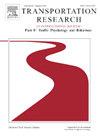Assessing effectiveness of intersection conflict warning system on driving performance under obstructed line of sight at unsignalized intersection
IF 3.5
2区 工程技术
Q1 PSYCHOLOGY, APPLIED
Transportation Research Part F-Traffic Psychology and Behaviour
Pub Date : 2025-02-17
DOI:10.1016/j.trf.2025.02.001
引用次数: 0
Abstract
Intersection Conflict Warning System (ICWS) is an Intelligent Transportation System (ITS) technology that has been recognized as a solution to reduce crashes at unsignalized intersections. It consists of activated warning signs and sensors that detect vehicles approaching an intersection, transmitting a warning signal to potentially conflicting vehicles on other approaches. The current study examines the effect of ICWS on drivers driving performance while approaching an unsignalized intersection under obstructed line of sight. Four scenarios were developed to evaluate the effectiveness of ICWS. Driving performance measures such as mean and standard deviation of speed and deceleration, and driver factors such as age and number of driving days per week were analyzed using repeated measures ANOVA. Furthermore, duration variables such as response time and speed reduction time were modelled using Weibull Accelerated Failure Time (AFT) duration model. The study insights showed statistical differences among the four scenarios for all driving performance measures. The developed model revealed that with activated ICWS, drivers exhibited longer speed reduction times and shorter response times. This implies that with the activated ICWS, drivers managed to respond to the conflicting vehicle beforehand, resulting in less abrupt braking behaviour and collision avoidance at the intersection. The study highlights the significance of ICWS and will assist traffic engineers and road safety authorities in designing and implementing ICWS at unsignalized intersections in developing world traffic.
求助全文
约1分钟内获得全文
求助全文
来源期刊
CiteScore
7.60
自引率
14.60%
发文量
239
审稿时长
71 days
期刊介绍:
Transportation Research Part F: Traffic Psychology and Behaviour focuses on the behavioural and psychological aspects of traffic and transport. The aim of the journal is to enhance theory development, improve the quality of empirical studies and to stimulate the application of research findings in practice. TRF provides a focus and a means of communication for the considerable amount of research activities that are now being carried out in this field. The journal provides a forum for transportation researchers, psychologists, ergonomists, engineers and policy-makers with an interest in traffic and transport psychology.

 求助内容:
求助内容: 应助结果提醒方式:
应助结果提醒方式:


